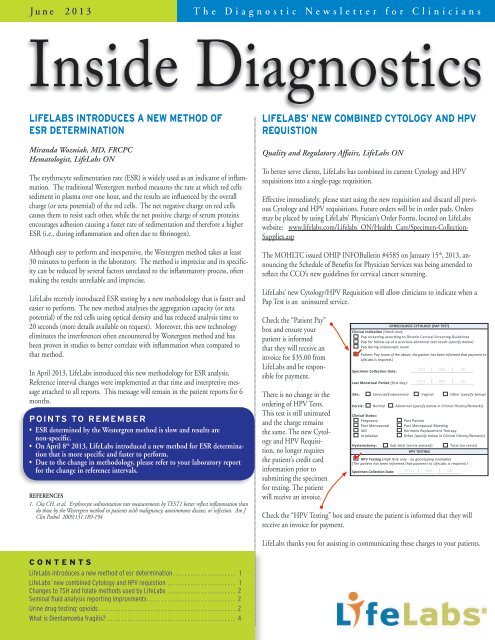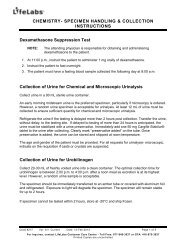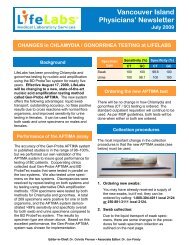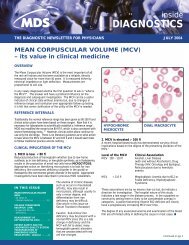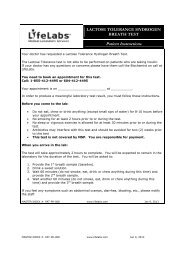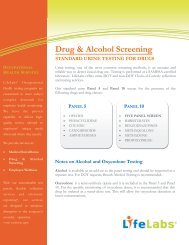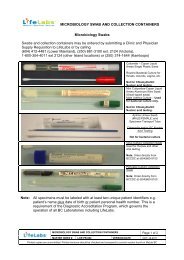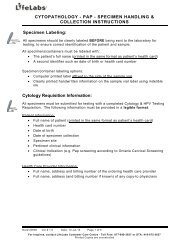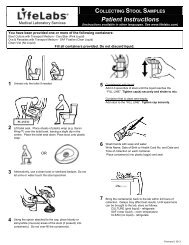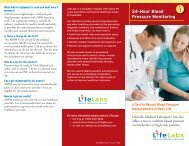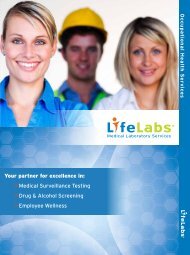Inside Diagnostics - June 2013 - Lifelabs
Inside Diagnostics - June 2013 - Lifelabs
Inside Diagnostics - June 2013 - Lifelabs
Create successful ePaper yourself
Turn your PDF publications into a flip-book with our unique Google optimized e-Paper software.
J u n e 2 0 1 3<br />
T h e D i a g n o s t i c N e w s l e t t e r f o r C l i n i c i a n s<br />
<strong>Inside</strong> <strong>Diagnostics</strong><br />
LIFELABS INTRODUCES A NEW METHOD OF<br />
ESR DETERMINATION<br />
Miranda Wozniak, MD, FRCPC<br />
Hematologist, LifeLabs ON<br />
The erythrocyte sedimentation rate (ESR) is widely used as an indicator of inflammation.<br />
The traditional Westergren method measures the rate at which red cells<br />
sediment in plasma over one hour, and the results are influenced by the overall<br />
charge (or zeta potential) of the red cells. The net negative charge on red cells<br />
causes them to resist each other, while the net positive charge of serum proteins<br />
encourages adhesion causing a faster rate of sedimentation and therefore a higher<br />
ESR (i.e., during inflammation and often due to fibrinogen).<br />
Although easy to perform and inexpensive, the Westergren method takes at least<br />
30 minutes to perform in the laboratory. The method is imprecise and its specificity<br />
can be reduced by several factors unrelated to the inflammatory process, often<br />
making the results unreliable and imprecise.<br />
LifeLabs recently introduced ESR testing by a new methodology that is faster and<br />
easier to perform. The new method analyzes the aggregation capacity (or zeta<br />
potential) of the red cells using optical density and has reduced analysis time to<br />
20 seconds (more details available on request). Moreover, this new technology<br />
eliminates the interferences often encountered by Westergren method and has<br />
been proven in studies to better correlate with inflammation when compared to<br />
that method.<br />
In April <strong>2013</strong>, LifeLabs introduced this new methodology for ESR analysis.<br />
Reference interval changes were implemented at that time and interpretive message<br />
attached to all reports. This message will remain in the patient reports for 6<br />
months.<br />
Points to Remember<br />
• ESR determined by the Westergren method is slow and results are<br />
non-specific.<br />
• On April 8 th <strong>2013</strong>, LifeLabs introduced a new method for ESR determination<br />
that is more specific and faster to perform.<br />
• Due to the change in methodology, please refer to your laboratory report<br />
for the change in reference intervals.<br />
References<br />
1. Cha CH. et al. Erythrocyte sedimentation rate measurements by TEST1 better reflect inflammation than<br />
do those by the Westergren method in patients with malignancy, autoimmune disease, or infection. Am J<br />
Clin Pathol 2009;131:189-194<br />
LIFELABS’ NEW COMBINED CYTOLOGY AND HPV<br />
REQUISTION<br />
Quality and Regulatory Affairs, LifeLabs ON<br />
To better serve clients, LifeLabs has combined its current Cytology and HPV<br />
requisitions into a single-page requisition.<br />
CYTOLOGY & HPV TEST<br />
Effective immediately, please start using the new requisition and discard all previous<br />
Cytology and HPV requisitions. Future orders will be in order pads. Orders<br />
Laboratory Use Only<br />
may be placed by using LifeLabs’ Physician’s Order Forms, located on LifeLabs<br />
Requesting Clinician/Practitioner<br />
website: www.lifelabs.com/<strong>Lifelabs</strong>_ON/Health_Care/Specimen-Collection-<br />
Name<br />
Supplies.asp<br />
The MOHLTC issued OHIP INFOBulletin #4585 on January 15 th Clinician/Practitioner Billing Number<br />
, <strong>2013</strong>, announcing<br />
the Schedule of Benefits for Physician Services was being amended to<br />
Copy to Clinician(s)/Practitioner(s) (fill all fields):<br />
reflect the CCO’s new guidelines for Namecervical cancer screening. Billing #<br />
LifeLabs’ new Cytology/HPV Requisition will allow clinicians to indicate when a<br />
Pap Test is an uninsured service.<br />
Name Billing #<br />
Check the “Patient Pay”<br />
box and ensure your<br />
patient is informed<br />
that they will receive an<br />
invoice for $35.00 from<br />
LifeLabs and be responsible<br />
for payment.<br />
There is no change in the<br />
ordering of HPV Tests.<br />
This test is still uninsured<br />
and the charge remains<br />
the same. The new Cytology<br />
and HPV Requisition,<br />
no longer requires<br />
the patient’s credit card<br />
information prior to<br />
submitting the specimen<br />
for testing. The patient<br />
will receive an invoice.<br />
GYNECOLOGIC CYTOLOGY (PAP TEST)<br />
Clinical Indication (check one):<br />
Pap screening according to Ontario Cervical Screening Guidelines<br />
Pap for follow-up of a previous abnormal test result (specify below)<br />
S<br />
Pap during colposcopic exam<br />
Patient Pay (none of the above; the patient has been informed that payment to<br />
LifeLabs is required.)<br />
Urin<br />
Res<br />
Specimen Collection Date:<br />
YYYY MM DD<br />
Site<br />
Last Menstrual Period (first day): YYYY MM DD<br />
Flui<br />
Hysterectomy: Sub-total (cervix present) Total (no cervix)<br />
HPV TESTING<br />
HPV Testing (High Risk only - no genotyping available)<br />
(The patient has been informed that payment to LifeLabs is required.)<br />
Specimen Collection Date: YYYY MM DD<br />
Clinical History/Remarks:<br />
Inadequate clinical information may hinder diagnosis. For accurate and<br />
Check the “HPV Testing” box and Laboratory ensure Use the Onlypatient is informed that they will<br />
receive an invoice for payment.<br />
XXX-FORMCYTO (04/13)<br />
Address<br />
Address<br />
Address<br />
Clinician/Practitione<br />
Health Card Numbe<br />
Province<br />
LifeLabs thanks you for assisting in communicating these charges to your patients.<br />
Other P<br />
Patient Last Name (a<br />
Patient First Name &<br />
Patient Address (inc<br />
Site: Cervical/Endocervical Vaginal Other (specify below)<br />
Site<br />
Cervix: Normal Abnormal (specify below in Clinical History/Remarks)<br />
Thy<br />
Clinical Status:<br />
Pregnancy<br />
Post Menopausal<br />
IUD<br />
Irradiation<br />
Post Partum<br />
Post Menopausal Bleeding<br />
Hormone Replacement Therapy<br />
Other (specify below in Clinical History/Remarks)<br />
Bre<br />
Fine<br />
Oth<br />
C O N T E N T S<br />
LifeLabs introduces a new method of esr determination . . . . . . . . . . . . . . . . . . . . . 1<br />
LifeLabs’ new combined Cytology and hpv requistion . . . . . . . . . . . . . . . . . . . . . . . 1<br />
Changes to tsh and folate methods used by LifeLabs . . . . . . . . . . . . . . . . . . . . . . . . 2<br />
Seminal fluid analysis reporting improvments . . . . . . . . . . . . . . . . . . . . . . . . . . . . . . 2<br />
Urine drug testing: opioids . . . . . . . . . . . . . . . . . . . . . . . . . . . . . . . . . . . . . . . . . . . . . . . . 2<br />
What is Dientamoeba fragilis . . . . . . . . . . . . . . . . . . . . . . . . . . . . . . . . . . . . . . . . . . . . . 4
2<br />
POINTS TO REMEMBER<br />
• LifeLabs has combined its current Cytology/HPV requisitions into a<br />
single-page requisition.<br />
• LifeLabs’ new Cytology/HPV Requisition will allow clinicians to indicate<br />
when a Pap Test is an uninsured service.<br />
• There is no change to the ordering process for HPV tests.<br />
CHANGES TO TSH AND FOLATE METHODS USED<br />
BY LIFELABS<br />
Peter Catomeris, PhD, FCACB<br />
Clinical Biochemist, LifeLabs ON<br />
In the near future, LifeLabs will implement changes to methods used to quantitate<br />
TSH and folate. The changes in testing technology will result in modifications<br />
to reference intervals. An interpretive comment explaining the change will<br />
be included in patient reports.<br />
TSH<br />
The current TSH method will be replaced by a third-generation assay, with improved<br />
analytical sensitivity, but will be performed on the same testing platform.<br />
The current assay standardization is traceable to the World Health Organization<br />
(WHO) 2 nd International Standard for human TSH (IRP 80/558), while the<br />
new assay standardization is traceable to the WHO 3 rd International Standard for<br />
human TSH (IRP 81/565).<br />
With the change to the method, TSH results are expected to decrease by about<br />
20% and reference intervals will be adjusted accordingly.<br />
Serum and RBC Folate<br />
Serum and RBC folate methods will be transferred to a new testing platform. As<br />
no international standard exists for folate, the methods are traceable to internal<br />
standards for each manufacturer.<br />
With the changes to the methods, results for serum folate are expected to increase<br />
by about 30%-40% and results for RBC folate are expected to double. Reference<br />
intervals for both tests will be adjusted accordingly.<br />
Please contact one of the Clinical Biochemists on LifeLabs’ Medical/Scientific<br />
Team for more information.<br />
POINTS TO REMEMBER<br />
• In the near future, LifeLabs will implement changes to methods used to<br />
quantitate TSH and folate.<br />
• Reference intervals for both methods will be adjusted to reflect the change<br />
in methodology.<br />
• An interpretive comment explaining the change will be included in patient<br />
reports.<br />
Reports that include multiple parameters may be overwhelming to review and<br />
interpret. Many of the diagnoses have been revised, and others condensed or otherwise<br />
improved. With these reporting modifications we hope physicians will now<br />
be able to look at these reports and immediately understand what requires special<br />
attention, saving time and reducing errors.<br />
LifeLabs welcomes your feedback and continuous improvement. Keep the suggestions<br />
coming!<br />
POINTS TO REMEMBER<br />
• Post-vasectomy and seminal analysis reports have been revised for content,<br />
layout, and accuracy.<br />
Urine Drug Testing: Opioids<br />
Danijela Konforte, PhD<br />
Clinical Biochemist, LifeLabs ON<br />
Common questions received at LifeLabs are related to interpretation of drugs<br />
of abuse reports, the majority of which are related to opioids. This article will<br />
discuss test methods for detection of opioids in urine, their utility and limitations.<br />
The opioids are a class of drugs that have analgesic, antitussive, and antidiarrheal<br />
properties. They are most commonly used in acute and chronic pain management,<br />
but they also have high potential for abuse or misuse. Opioids may be<br />
divided into three main classes: a) natural (from opium), i.e., morphine, codeine;<br />
b) semi-synthetic, i.e., hydromorphone, hydrocodone, oxycodone, oxymorphone,<br />
heroin, and buprenorphine; and, c) synthetic, i.e., meperidine, fentanyl, methadone,<br />
tramadol, propoxyphene, tapentadol.<br />
The metabolism of common opioids is reflected in Table 1. Understanding basic<br />
opioid metabolism will enhance urine drug test result interpretation.<br />
Table 1: Metabolism of Common Opioids<br />
Parent drug<br />
Morphine<br />
Heroin<br />
Codeine<br />
Oxycodone<br />
Metabolite<br />
Hydromorphone<br />
6-monoacetylmorphine (short-lived<br />
metabolite)<br />
Morphine<br />
Morphine (major metabolite)<br />
Hydrocodone (minor metabolite)<br />
Oxymorphone<br />
Please note that information discussed in this article can be found in the latest<br />
Community Laboratories Guidelines for Ordering Urine Testing for Drugs-of-<br />
Abuse: Targeted and Screening Tests (CLP013) published by the Ontario<br />
Association of Medical Laboratories in March <strong>2013</strong>. 1<br />
SEMINAL FLUID ANALYSIS REPORTING<br />
IMPROVMENTS<br />
Shubhra Mohan<br />
Quality and Regularoty Affairs, LifeLabs ON<br />
Clients have recently reported that they have some difficulty reading and understanding<br />
LifeLabs’ post-vasectomy patient reports. Based on their feedback,<br />
LifeLabs revised not only post-vasectomy reports, but also other seminal analysis<br />
reports for content, layout and accuracy.<br />
l<br />
T h e D i a g n o s t i c N e w s l e t t e r f o r C l i n i c i a n s - O n t a r i o<br />
Methods for Detection of Opioids in Urine<br />
a) Opioid immunoassay (IA) screens<br />
Opioid IA screens are designed to detect opioids that are structurally similar to<br />
morphine, including codeine, hydrocodone, and hydromorphone (Table 2).<br />
Results are qualitative and drug concentrations are not provided. Results equal<br />
to or above the screen cutoff of 300 ug/L are reported as “Detected”, results<br />
below the screen cutoff are reported as “Not Detected”.<br />
In the emergency care setting qualitative opiate IA screens are used to evaluate<br />
potential drug abuse or overdose. In the community setting opioid IA screens<br />
are most commonly used to identify use of undisclosed opioids, to determine<br />
compliance with prescribed opioid, and to uncover diversion of prescribed opioid.
Table 2: Examples of Opioids Commonly Detected<br />
by Urine Immunoassay Screen and Broad Spectrum<br />
Toxicology Screen<br />
Opioid Immunoassay (IA) Screen*<br />
(Order on its own or with DOA screen)<br />
Morphine<br />
Morphine metabolite<br />
(Morphine-3-glucuronide)<br />
Codeine<br />
Hydrocodone<br />
Hydromorphone<br />
6-acetyl morphine (heroin metabolite)<br />
Dihydrocodeine<br />
Levorphanol<br />
Broad Spectrum Toxicology Screen #<br />
(Chromatography-Mass Spectrometry<br />
technology)<br />
Morphine<br />
Morphine metabolite<br />
(Morphine-3-glucuronide)<br />
Codeine<br />
Hydrocodone<br />
Hydromorphone<br />
6-acetyl morphine (Heroin metabolite)<br />
Dihydrocodeine<br />
Levorphanol<br />
Methadone<br />
Methadone metabolite<br />
Meperidine<br />
Fentanyl<br />
Norfentanyl<br />
Naloxone<br />
*Opioid IA Screen shows poor cross-reactivity with oxycodone, methadone, and methadone metabolite<br />
(EDDP). LifeLabs offers specific immunoassay tests that detect these opioids in urine.<br />
# Broad Spectrum Tox Screen method can detect additional opioids not listed in Table 2.<br />
How to order: Opioid IA screen may be requested either on its own or<br />
included in a ‘Drugs-of-Abuse (DOA) Screen’.<br />
b) Confirmation testing by chromatography-mass spectrometry<br />
Table 2 summarizes opioids commonly detected by IA screen and Broad Spectrum<br />
Toxicology Screen, respectively.<br />
Confirmatory opioid testing is used to determine the specific opioid abused by<br />
patients, identify the specific opioid that cannot be reliably detected with the<br />
IA screen due to poor cross-reactivity (i.e., synthetic opioids like meperidine<br />
and fentanyl), or to identify the presence of metabolites if there is a suspicion<br />
that a patient added the medication directly to their urine to simulate compliance<br />
(i.e., fentanyl present but not norphentanyl, methadone present but not<br />
EDDP).<br />
In these situations, it is recommended that the initial IA screen is followed by<br />
a more specific technique such as chromatography coupled to mass spectrometry<br />
to identify, or confirm the presence, or absence of a specific opioid and its<br />
metabolites.<br />
How to order: Confirmatory test can be ordered by requesting a ‘Broad<br />
Spectrum Toxicology Screen’. If a specific drug(s) is of interest, the drug name<br />
should be noted in the ‘Other Tests’ section of the OHIP lab requisition.<br />
To request confirmation testing on a urine specimen that tested positive by<br />
opioid IA screen, please call LifeLabs at 416-675-4530 ext. 3339.<br />
Limitations of Urine Opioid Screens<br />
a) A false-negative opioid IA screen: An opioid is present in the patient’s urine<br />
but the IA screen test is negative<br />
The most common causes of false-negative results are:<br />
• Drug concentration is present below the cutoff (< 300 ug/L)<br />
• The specific drug is not recognized by the IA screening assay<br />
• The patient took the drug too remotely from the time of urine collection<br />
• Specimen adulteration<br />
<br />
Some semi-synthetic and most synthetic opioids will have variable cross-reactivity<br />
in opioid immunoassays routinely available in the laboratory. In these<br />
circumstances, either specific IA for drugs such as oxycodone and methadone/<br />
methadone metabolite can be ordered, or broad spectrum toxicology confirmatory<br />
screen for drugs like hydromorphone, meperidine, and fentanyl may be<br />
requested.<br />
It is important to note the window for detection of opioid in urine is approximately<br />
2 to 4 days after last use. This depends on many factors including<br />
method and frequency of opioid ingestion, opioid half-life, fluid intake, and<br />
the patient’s metabolism and physical condition. The duration of positive<br />
results for the drug should be considered in interpreting both negative and<br />
positive screen results. A detailed discussion of this topic is presented in Life-<br />
Labs <strong>Inside</strong> <strong>Diagnostics</strong> article published in July 2011. (Please see our website:<br />
www.lifelabs.com)<br />
Sometimes the drug cannot be detected due to urine adulteration by the<br />
patient. Overhydration is the most common form of pre-collection urine<br />
adulteration. Patients drink large amount of water to dilute their urine so that<br />
the drug level is below the assay cutoff. Common post-collection adulterants<br />
include dilution of the urine with bleach, vinegar, soap, ammonia, lemon<br />
juice, drain cleaner, table salt, various chemicals such as peroxide/peroxidase,<br />
nitrite or chromate. In an effort to identify possible sample manipulation and<br />
ensure correct result interpretation, the laboratory tests for urine creatinine,<br />
specific gravity, and pH to verify urine integrity.<br />
b) A false-positive opioid IA screen: An opioid is absent from the patient’s<br />
urine, an IA screen is positive, and a confirmatory test is negative.<br />
The most common causes of false-positive results are:<br />
• Poppy seed ingestion (poppy seed cookies or bagels can cause a positive<br />
opioid IA screen due to presence of morphine and codeine in the seed.)<br />
Codeine and morphine containing analgesic medications can produce<br />
positive opioid screen results. These are both examples of true-positive but<br />
misleading results.<br />
• Limitations in specificity of the antibodies used in the analytical method.<br />
The antibodies used in opioid IA screens bind to drugs that are structurally<br />
related to the opioids but many also cross react with compounds that are<br />
not structurally-related to the opioids that the assay is designed to detect.<br />
For example, therapeutic doses of quinolone antibiotics (levofloxacin,<br />
ofloxacin) that are not structurally related to the opioid can produce false<br />
positive results on opioid screens. Other agents that can cause false-positive<br />
results include dextromethorphan, diphenhydramine and verapamil (methadone<br />
IA only), rifampin, chlorpromazine, and quinine.<br />
For assistance in the interpretation of urine opioid test results and for more<br />
information on the available testing methods, please contact one of the Clinical<br />
Biochemists on LifeLabs’ Medical/Scientific Team.<br />
POINTS TO REMEMBER<br />
• Opioid immunoassay screen detects natural and most semi-synthetic opioids,<br />
but each kit will have variable cross-reactivity with synthetic opioids.<br />
• Oxycodone and Methadone/EDDP – specific immunoassay screens are<br />
available and should be ordered separately from the opioid screen. Broad<br />
spectrum toxicology screen (by chromatography-mass spectrometry) detects<br />
most classes of opioids.<br />
• The absence of expected opioid may indicate non-compliance, inappropriate<br />
timing of urine collection relative to drug administration, diluted/<br />
adulterated urine, or limitations of testing. The concentration of the drug<br />
in urine must be greater than or equal to the cutoff that is reported as<br />
detected.<br />
3<br />
T h e D i a g n o s t i c N e w s l e t t e r f o r C l i n i c i a n s - O n t a r i o<br />
l
4<br />
References<br />
1. Community Laboratories Guidelines: Guidelines for Ordering Urine Testing for Drugs-of-Abuse: Targeted<br />
and Screening Tests (CLP013). March <strong>2013</strong> (http://www.oaml.com/documents/OAMLGUIDE-<br />
LINEFORORDERINGDOAFINALMarch14<strong>2013</strong>.pdf)<br />
2. Trescot AM et al. Opioid guidelines in the management of chronic non-cancer pain. Pain Physician.<br />
2006; 9:1-39.<br />
3. Moeller KE, et al. Urine Drug Screening: Practical Guide for Clinicians. Mayo Clinical Proceedings.<br />
2008;83(1):66-76.<br />
4. Joely A et al. Opiate-positive Immunoassay Screen in a Pediatric Patient. Clinical Chemistry. 2010;<br />
56(8):1220-1225.<br />
5. Cheryk L and Langman L. Drug-of-abuse testing: Understanding the Limitations. American Association<br />
of Clinical Chemistry: Clinical Laboratory News. January 2008;8-10.<br />
WHAT IS Dientamoeba fragilis<br />
Abdel Belhaj, MD, FRCPC<br />
Consultant Microbiologist, LifeLabs ON<br />
Dientamoeba fragilis is an anaerobic intestinal protozoan parasite. Historically,<br />
this organism was amongst a group of enteric protozoan parasites beginning with<br />
Giardia lamblia that were initially believed to be commensals and not capable<br />
of causing symptomatic illness. As more information became available and antimicrobial<br />
agents were developed with activity against these parasites, it became<br />
clear that D. fragilis is an active infection, although not always symptomatic.<br />
Microbiology<br />
Although initially identified as an amoeba, ultrastructural, immunologic and<br />
genetic analyses place this organism in the family of protozoan flagellates, which<br />
includes Trichomonas. Unlike other intestinal protozoan organisms that have<br />
both trophozoite and hardy cyst stages, Dientamoeba fragilis apparently exist only<br />
as trophozoites. Trophozoites measure 7 to 12 micrometers in diameter, contain<br />
one or two nuclei, lack flagellae, and are minimally motile.<br />
Epidemiology<br />
Infections with Dientamoeba fragilis undoubtedly are acquired by the fecal-oral<br />
route, but how fragile trophozoites survive outside of the body and do not succumb<br />
to stomach acid following ingestion is unknown. Some earlier investigators<br />
suggested that trophozoites might survive within and be ingested with the<br />
eggs of the pinworm, Enterobius vermicularis.<br />
It is distributed globally; the prevalence varies with geography. D. fragilis represents<br />
about 50 percent of all pathogenic parasites identified in the parasitology<br />
laboratory at LifeLabs. About 2-3% of all stool samples that are sent to our<br />
laboratory for parasitology testing is shown to have D.fragilis. (based on data<br />
from Jan-March <strong>2013</strong>).<br />
Clinical Manifestations<br />
The incubation period prior to the onset of symptoms following infection is<br />
unknown, as is the proportion of infected people who remain asymptomatic.<br />
The parasite localizes in the colon and can cause colitis. Most common symptoms<br />
are: abdominal pain, diarrhea, anorexia, fatigue, nausea, weight loss and<br />
vomiting. Patients with D. fragilis may present with peripheral eosinophilia and/<br />
or eosinophilic colitis.<br />
Diagnosis<br />
The diagnosis is made via detection of D. fragilis trophozoites in microscopic examinations<br />
of appropriately fixed and stained stool samples (Figure 1). Examination<br />
of formed, as well as watery, stools increases the diagnostic yield.<br />
Figure 1: D. fragilis in a Stool Sample Stained with<br />
Kinyoun/Hematoxylin<br />
Treatment and<br />
Prevention<br />
Infections with Dientamoeba fragilis<br />
should be treated when the organism<br />
is found as a sole pathogen in stool<br />
samples from patients with abdominal<br />
pain or diarrhea lasting for more than<br />
one week.<br />
There are several regimens that may be used to treat D. fragilis infections including:<br />
Paromomycin, Metronidazole and Iodoquinol.<br />
The literature is suggestive of Paromomycin as a more efficacious agent than<br />
Metronidazole.<br />
Since knowledge is currently lacking about how Dientamoeba fragilis infections are<br />
transmitted, there are no specific guidelines on measures to prevent acquisition of<br />
infection with this parasite other than good hand hygiene.<br />
POINTS TO REMEMBER<br />
• Dientamoeba fragilis is an anaerobic intestinal protozoan parasite. It is a<br />
flagellate that produces trophozoites; cysts have not been identified.<br />
Infection may be symptomatic or asymptomatic.<br />
• Infection is transmitted by the fecal-oral route.<br />
• Common symptoms include abdominal pain and recurrent diarrhea.<br />
• Patients with D. fragilis may present with peripheral eosinophilia and/or<br />
eosinophilic colitis.<br />
• The diagnosis is made via detection of D. fragilis trophozoites in microscopic<br />
examinations of appropriately fixed and stained stool samples.<br />
• Treatment is warranted when the organism is found as a sole pathogen in<br />
stool samples in the setting of abdominal pain or diarrhea lasting more<br />
than one week. The literature suggests treatment with Paromomycin.<br />
References<br />
1. Girginkardeşler N, Coşkun S, Cüneyt Balcioğlu I, et al. Dientamoeba fragilis, a neglected cause of diarrhea,<br />
successfully treated with secnidazole. Clin Microbiol Infect 2003; 9:110.<br />
2. Grendon JH, Digiacomo RF, Frost FJ. Dientamoeba fragilis detection methods and prevalence: a survey<br />
of state public health laboratories. Public Health Rep 1991; 106:322.<br />
3. Stark D, Barratt J, Roberts T, et al. A review of the clinical presentation of dientamoebiasis. Am J Trop<br />
Med Hyg 2010; 82:614.<br />
4. Cuffari C, Oligny L, Seidman EG. Dientamoeba fragilis masquerading as allergic colitis. J Pediatr<br />
Gastroenterol Nutr 1998; 26:16.<br />
5. Hiatt RA, Markell EK, Ng E. How many stool examinations are necessary to detect pathogenic intestinal<br />
protozoa Am J Trop Med Hyg 1995; 53:36.<br />
6. Drugs for Parasitic Infections, 2nd Ed, The Medical Letter, Inc, New Rochelle, NY 2010.<br />
7. Vandenberg O, Souayah H, Mouchet F, et al. Treatment of Dientamoeba fragilis infection with paromomycin.<br />
Pediatr Infect Dis J 2007; 26:88.<br />
For more information,<br />
Contact:<br />
Dr. Doug Tkachuk<br />
Chief Medical Officer<br />
416-675-4530 ext. 2990<br />
doug.tkachuk@lifelabs.com<br />
Dr. Virginia Walley<br />
Ontario Medical Director<br />
416-675-4530 ext. 2811<br />
virginia.walley@lifelabs.com<br />
Dr. Sheila Boss<br />
Discipline Head, Biochemistry<br />
and Laboratory Director<br />
416-675-4530 ext. 2296<br />
sheila.boss@lifelabs.com<br />
Dr. Huda Almohri<br />
Microbiology Discipline Head<br />
416-675-4530 ext. 2105<br />
huda.almohri@lifelabs.com<br />
Dr. Abdel Belhaj<br />
Medical Microbiologist<br />
416-675-4530 ext. 2344<br />
abdel.belhaj@lifelabs.com<br />
Dr. Peter Catomeris<br />
Clinical Biochemist<br />
416-675-4530 ext. 2029<br />
peter.catomeris@lifelabs.com<br />
Dr. Daniela Leto<br />
Medical Microbiologist<br />
416-675-4530 ext. 2898<br />
daniela.leto@lifelabs.com<br />
Dr. Miranda Wozniak<br />
Hematology Discipline Head<br />
416-675-4530 ext. 2040<br />
miranda.wozniak@lifelabs.com<br />
Dr. Kika Veljkovic<br />
Clinical Biochemist<br />
416-675-4530 ext.2832<br />
kika.veljkovic@lifelabs.com<br />
Dr. Danijela Konforte<br />
Clinical Biochemist<br />
416-675-4530 ext.2208<br />
danijela.konforte@lifelabs.com<br />
l<br />
T h e D i a g n o s t i c N e w s l e t t e r f o r C l i n i c i a n s - O n t a r i o


